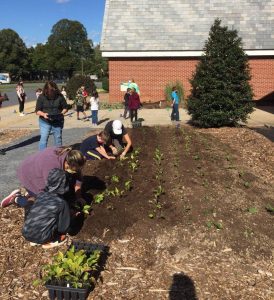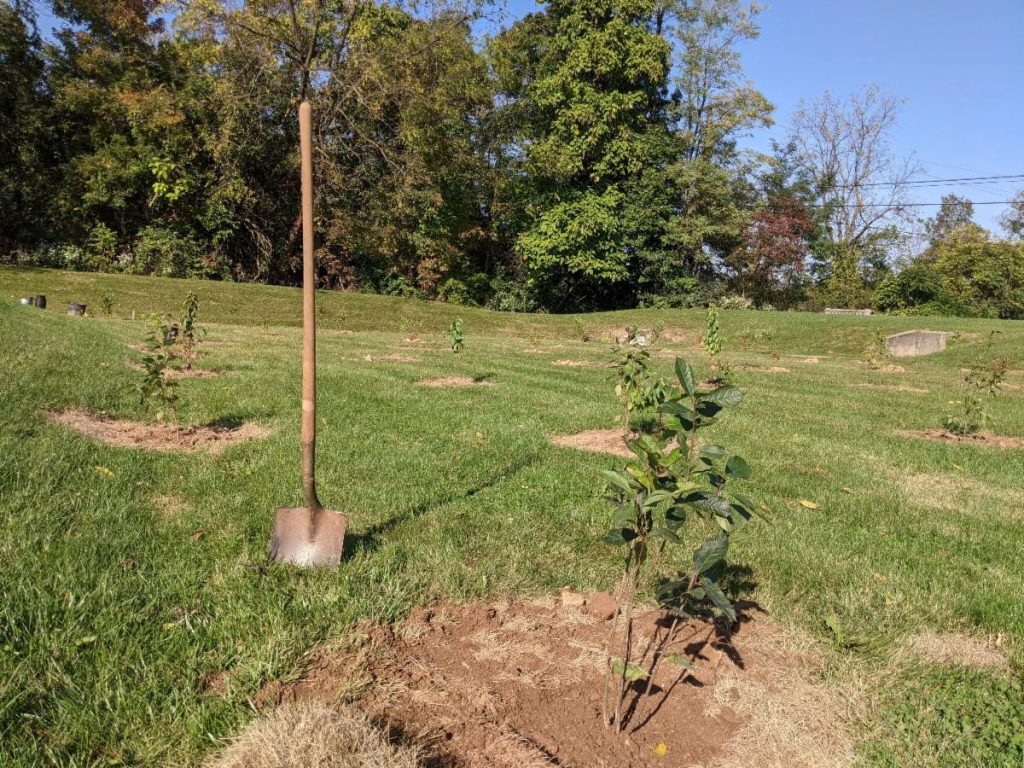“This was the garden,
It didn’t look like much,
But it meant everything to its gardener.”
The Little Gardener by Emily Hughes
To some people, the Andrew Maier Elementary School campus didn’t look like much.
The immense lawn had been mowed and manicured into a sterile monoculture of turf, affording no space for shade-giving trees or sweet-smelling flowers. Along the western border of campus, an impenetrable wall of disruptive, non-native plants suffocated the banks of a small creek, completely obscuring the waterway from view and doing little to protect the creek from stormwater runoff.
But Connie Cammarano, a counselor at Andrew Maier Elementary School, saw the untapped potential in her campus; and growing that dull configuration of grass and pavement into a garden of opportunity meant everything to her and the Andrew Maier community.
Following her Master Naturalist training, Cammarano reached out to Larry Lloyd, Senior Ecologist at Berks Nature for help. Together, Lloyd and Cammarano, along with Andrew Maier’s Principle, Chris Redding, designed a green infrastructure improvement project for the Andrew Maier Elementary School campus; they called it, “Learning by Nature”.
The Learning by Nature comprehensive plan includes several initiatives, collectively designed to provide Andrew Maier’s 240 elementary students, their families, and innumerable community members with access to improved wildlife habitat, immersive education experiences, and exposure to sustainable, environmentally-responsible school campus management practices.
The new and improved campus will feature a stormwater basin lush with native shrubs to allow increased stormwater infiltration, a nature play area equipped with logs, boulders, and other natural materials to encourage creative play, and several new plantings of native trees and wildflowers to increase carbon sequestration, provide shade, and create habitat for pollinators.
These new “green” spaces are perfect for hands-on learning; an innovative curriculum will provide students with engaging and meaningful experiences outside to learn from and better understand the natural world. New, stabilized access to the creek will allow students to monitor water quality, wildflower plantings will provide a peaceful setting for teaching lessons on pollinators, and bird feeders will allow students to observe and identify their feathered neighbors. All this and more, without ever leaving campus!

But Andrew Maier Elementary needed help to make their Learning by Nature dream a reality. First, the Schuylkill Highlands Mini-Grant Program, generously contributed $8,000 to support the project, providing enough funds to purchase the native trees, plants, and wildflowers to cultivate their campus transformation.
Then, local Eagle Scout Jay Molleca took on the task of building a pollinator garden. Molleca planned and measured the future garden’s dimensions and helped Berks Nature prepare the site for installation. In August 2020, a group of 14 Boy Scouts helped Molleca build the pollinator garden of Cammarano’s dreams.
Next, former Fleetwood Area School District student, Ripley Price, now a Venturer with Crew 5.14 from Hawk Mountain Council, created two bee homes for the school to install in the pollinator garden. These shelters were specifically designed to suit native mason and leafcutter bees.
Now, just two months later, Andrew Maier Elementary is taking its next big step towards growing their Learning by Nature campus.
In a three-day, community-wide effort, 116 trees and shrubs plus nearly 800 native wildflowers and other herbaceous plants were planted at Andrew Maier Elementary School.
Community volunteers from First Energy, the Mid-Atlantic Renewable Energy Association, and the Pennsylvania Master Naturalist program along with Berks Nature staff and intern, Dustin Graczyk, planted shrubs and trees in the school’s stormwater retention basin and along the perimeter of the playground to reduce stormwater runoff and encourage groundwater recharge. As these woody plants take root and grow, they will provide shelter to wildlife, absorb and store carbon, and cast shade for weary children on sunny days.
Andrew Maier faculty helped students plant flowers in the pollinator garden. The children eagerly dug into the soil, reveling at the opportunity to use their hands. Even the novice gardeners, tentative at first, found new satisfaction moving the young flowers into their new homes. All around, dirty hands made for big smiles, the warm glow of stewardship and pride alight in their young hearts.
This was the school, and it didn’t look like much, but with help from the whole community, nature has taken root.
This project was funded in part by a grant from the Community Conservation Partnership Program, under the administration of the Pennsylvania Department of Conservation and Natural Resources, Bureau of Recreation in support of the Schuylkill Highlands Mini-Grant Program administered by Natural Lands Trust.




